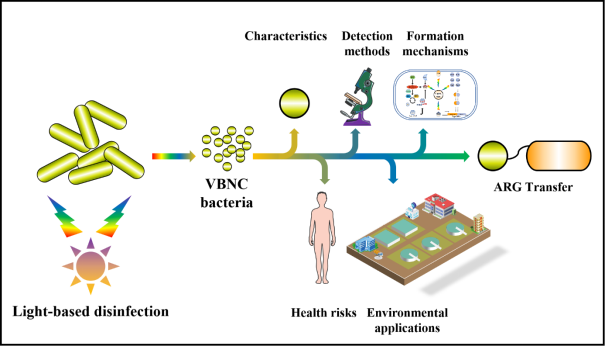近日,广东工业大学环境健康与污染控制研究院、环境科学与工程学院安太成教授团队题为《Formation mechanisms of viable but nonculturable bacteria through induction by light-based disinfection and their antibiotic resistance gene transfer risk: a review》的综述性论文在Critical Reviews in Environmental Science and Technology (CREST,http://dx.doi.org/10.1080/10643389.2021.1932397)杂志上发表。论文的第一作者为博士研究生蔡仪威,第二作者为硕士研究生刘建莹,通讯作者为安太成教授和李桂英教授。该综述全面系统地阐述了污水消毒领域活的不可培养细菌方面的最新研究进展和挑战,综述内容包括活的不可培养细菌的分析方法、基本形态和生理特征、健康风险和环境应用等领域。同时论文还系统总结了光消毒技术与其它处理条件对活的不可培养细菌的诱导作用机制,解释了活的不可培养细菌对污水消毒领域带来的可能危害。该综述还重点关注了活的不可培养细菌迁移转化过程中潜在的耐药基因的水平转移概率与耐药性传播的健康风险,为抗生素耐药性的传播和扩散提供了新的见解。

消毒技术,特别是基于光相关的消毒技术,已经经历了巨大的发展和创新,但这种处理方式可能会在不同的使用条件下导致细菌进入活的不可培养(VBNC)状态。VBNC细菌由于其强大的耐受特性,导致消毒技术无法彻底消除它们,从而造成了潜在的细菌逃逸处理和净化,甚至提高了后续耐药基因(ARGs)水平转移的风险。因此,为了更好地了解VBNC细菌,解释其在光消毒技术中的迁移转化机制及其ARGs潜在的转移风险,本文首先系统综述了形成VBNC状态后细菌的形态学、生理学和毒力学等特征的变化。其次系统回顾了VBNC细菌的定量检测方法,总结了包括基于细胞膜完整性的活死染色法、基于qPCR基因表达的测定法和基于噬菌体的相关活细胞检测法。考虑到目前检测手段的局限性和应用范围,本文还提出了目前仍然缺乏能够基于原位和实时测定的检测新技术的观点。本文随后系统地对VBNC的健康风险和环境应用进行了评价,阐释了VBNC细菌在微生物环境利用方面的重要价值。更重要的是,本文着重总结和分析了VBNC细菌的诱导条件(特别强调了光消毒技术的诱导)及其形成机制,发现其形成机制主要涉及到了严谨反应、一般应激响应系统和毒素-抗毒素系统等。此外,我们还重点分析了光消毒技术诱导VBNC细菌形成过程中和形成后潜在的ARGs转移风险,包括接合、转化和转导等转移形式的基因水平转移发生概率。最后本文还在综述VBNC细菌的检测方法、形成机理、ARGs转移和潜在环境利用价值的基础上,总结了当前VBNC细菌研究现状的不足,并提出了4个未来的研究挑战:(1)污水处理行业仍缺乏基于原位和实时的VBNC细菌检测技术;(2)VBNC状态的形成和抗生素耐药性的获得之间的关联性机制仍需进一步大量研究;(3)VBNC细菌形成过程和形成后的ARGs转移仍需尧进一步的大量实验研究的支撑,并亟需阐明其转化机制;(4)开发VBNC细菌的普适性复苏技术会使得环境中丰富的VBNC细菌的价值得到进一步发挥,对未来微生物利用领域的发展极其重要。通过这些VBNC细菌相关科学知识的总结和系统梳理,从而可以帮助读者利于了解未来消毒技术(特别是光消毒技术)的发展和VBNC细菌相关领域的最新研究进展。
论文DOI:http://dx.doi.org/10.1080/10643389.2021.1932397
图文摘要:

英文摘要:
Disinfection technologies, especially light-based disinfection, have undergone tremendous development and innovation, but this treatment can cause bacteria to enterviable but nonculturable (VBNC) state. Due to their strong tolerance, VBNC bacteria cannot be completely removed by disinfection technologies, thereby posing a potential risk for antibiotic resistance gene (ARG) transfer. Therefore, to better understand VBNC bacteria and interpret potential transfer of ARGs, this article systematically reviewed changes in morphology, physiology and virulence of bacteria after entering VBNC state. In addition, this article reviewed quantitative detection methods of VBNC bacteria, such as cell membrane integrity-mediated LIVE/DEAD Baclight assay, qPCR-based assays, and phage-based detection methods, concluding that there is still a lack of in-situ and real-time detection methods forVBNC bacteria. Health risks and environmental application value of VBNC bacteria were then valuated, with data indicating that VBNC bacteria have great value in the domain of microbial utilization. Furthermore, the induction conditions (especially by light-based disinfection) and formation mechanisms of VBNC bacteria were highlighted. Formation mechanisms mainly involve stringent response, general stress response system and toxin-antitoxin (TA) system. Moreover, horizontal gene transfer (HGT) of ARGs during and after the formation of VBNC bacteria induced by light-based disinfection was evaluated. It was found that ARGs may be transferred through conjugation, transformation and transduction. Finally, current deficiencies and future challenges for the transformation of VBNC bacteria, especially those influenced by light-based disinfection technologies, were summarized.This review provides new insights into detection methods, formation mechanisms, environmental applications and potential ARG transfer risks ofVBNC bacteria.
项目资助:本研究受到国家自然科学基金项目(U1901210,42077333);广东省重点研发计划项目(2020B1111350002);广东省本土创新科研团队项目(2017BT01Z032)的资助。